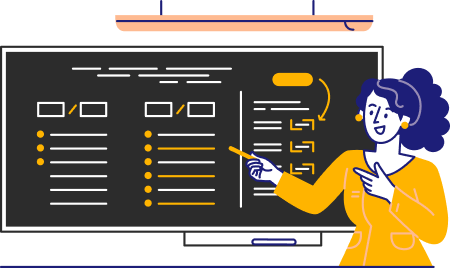It’s no surprise that the most important section of your resume is also the trickiest. Getting your job responsibilities just right can be the difference between a rejection and an interview. Why are they so important, you ask?
Well, when they’re done right, not only do they describe what your job responsibilities were but they also show off your technical skills, your soft skills, and your biggest achievements—all while helping your resume align perfectly with the job description.
It sounds difficult, but with our structured guide and handy tips, you’ll quickly see that writing the perfect job responsibilities is within your grasp! We even have plenty of snippets from resume templates for you to learn from, too. Let’s get started!
Understanding Job Responsibilities

So when you list your previous work experience on a resume, the format normally goes like this: job title, location, period of employment, and then a bunch of bullet points. Those bullet points are also known as “job responsibilities,” and they’re an extremely important part of your resume.
You only have a limited amount of words at your disposal but the goal is to both make it clear what you did in the role and make it clear that you did it well.

Definition and importance
The simplest way to think of a job responsibility is “what you were in charge of.” For example, assume you’re the head of food and beverage at a casino. One of your responsibilities is to make sure the bar is always fully stocked—this means you’re the one the boss will complain to if he sees the bar is low on some items. Or, on a positive note, you’re the one the boss will praise when he notices how full and perfect the bar looks!
The important thing about responsibilities is that they show that you were given responsibility by your employer. You were put in charge of some broad task, and you had to manage the details and act independently to make it a success. Proactivity and being able to work independently are important characteristics that employers are always looking out for.

Distinguishing between duties and responsibilities
When it comes to job descriptions and resumes, the word “responsibilities” often comes paired with “duties.” While these terms are sometimes used interchangeably, they’re actually quite different. Basically, if a responsibility is something you’re in charge of, duties are the individual tasks related to it.
So, if we go back to the head of food and beverage again, it’s your responsibility to keep the bar stocked. The duties related to this are doing stock-taking, buying stock, and stocking the shelves.
The problem with duties is that people have a habit of thinking of them as “things you’re told to do.” So, if you focus too much on duties and not enough on responsibilities, it can make it look like you only did what you were told to do rather than being proactive and contributing to the workplace yourself.
How to Articulate Your Responsibilities

When it comes to describing your job responsibilities effectively, all you need to do is remember that you’re trying to impress your reader. Whatever you write, read back through it and ask yourself: Does this sound impressive?
If all you do is list mundane day-to-day tasks, it won’t really sound that good, no matter what the tasks actually are.
To get into the right mindset, it’s often useful to think about former colleagues who did the same job as you. You all had the same duties or responsibilities but your methods and results likely differed. What did you do better than them and how did you do it?
Thinking about this will help you find details that not only describe what the role was but also showcase your personal successes within that role.

Using action verbs
Since you write the work experience section of your resume in bullet points, it means you don’t have to use full sentences. So, instead of starting every bullet point with “I,” you can skip straight to the verb. The good thing about this is when you use punchy action verbs, it grabs the reader’s attention. Here’s an example:
- Spearheaded the development and implementation of comprehensive food and beverage strategies.
It’s okay if you feel like you’re making something normal sound fancier than it is—writing a resume is all about selling your skills, so a bit of sales talk is unavoidable.

Quantifying achievements
Now, to make that example bullet point even better, we need to make it more tangible. Why should the reader care about these food and beverage strategies? Well, they should care because they were successful—so you need to quantify that success and make it obvious.
- Spearheaded the development and implementation of comprehensive food and beverage strategies, resulting in a 15% increase in overall revenue within the first year.
With this context added, your bullet point goes from sounding fancy, but without really saying anything, to showing your reader exactly how much value you can bring to the employer.
Of course, you might not know facts and figures like this off the top of your head, so figuring some out could take a little research.
Examples of Well-Written Job Responsibilities

The best way to get a feel for how this should be done is to look at examples. You can see for yourself how impressive they sound, and learn what kinds of words and phrases stand out the most.
Aside from how you write them, the other important thing about job responsibility bullet points is how relevant they are. Ideally, you want them to directly address the skills and requirements listed in the job description—which means adjusting them for every application.
It might sound complicated, but we’ll show you how it’s done!
Tech company example
Example skills and requirements from a tech company job description:
- Proficiency in HTML, CSS, and JavaScript.
- Experience with front-end frameworks such as React, Vue.js, or Angular.
- Familiarity with back-end technologies like Node.js, Express, or Django.
- Strong understanding of responsive design principles and cross-browser compatibility.
- Ability to work with version control systems such as Git.
- Knowledge of web performance optimization techniques.
- Excellent problem-solving skills and attention to detail.
- Bachelor’s degree in computer science, web development, or related field (or equivalent experience).
Example job responsibilities for a resume:
- Developed and maintained responsive websites for clients, resulting in a 20% increase in user engagement metrics.
- Implemented performance optimizations, reducing page load times by 30% and improving website ranking in search engine results.
- Collaborated with UX/UI designers to implement responsive design principles, resulting in a 40% increase in mobile traffic and improved user experience metrics.
Healthcare provider example
Example skills and requirements from a healthcare provider job description:
- Current and valid nursing license.
- Strong clinical skills and knowledge of medical procedures to treat patients.
- Ability to work well under pressure and in high-stress environments.
- Excellent communication and interpersonal skills.
- Compassionate and empathetic attitude toward patients.
- Attention to detail and ability to maintain accurate patient records.
- Ability to work collaboratively in a multidisciplinary team.
- Willingness to stay updated on medical advancements and best practices through continuing education.
Example job responsibilities for a resume:
- Administered medications and treatments to patients, achieving a 95% accuracy rate in medication administration.
- Assessed and monitored patient vital signs, implementing timely interventions that resulted in a 20% reduction in adverse events.
- Participated in interdisciplinary rounds, contributing to care planning and coordination, which led to a 15% decrease in patient readmission rates within the first six months.
Retail manager example
Example skills and requirements from a retail manager job description:
- Proven experience in retail management, preferably in a similar industry.
- Strong leadership and team management skills.
- Excellent customer service and communication abilities.
- Proficiency in inventory management and sales forecasting.
- Ability to analyze sales data and develop strategies to improve performance.
- Understanding of retail operations and ability to optimize processes for efficiency.
- Flexibility to work varying shifts, including evenings, weekends, and holidays.
- Bachelor’s degree in business administration, retail management, or related field (preferred).
Example job responsibilities for a resume:
- Managed a team of 20+ retail associates, achieving a 10% increase in sales through effective coaching and performance management.
- Implemented inventory control measures, resulting in a 15% reduction in stock shrinkage and improved accuracy in inventory tracking.
- Implemented a customer feedback system and trained staff to provide exceptional service, resulting in a 20% improvement in customer satisfaction scores over a six-month period.
Manufacturing supervisor example
Example skills and requirements from a manufacturing supervisor job description:
- Previous experience in manufacturing or production supervision.
- Strong leadership and team management skills.
- Knowledge of manufacturing processes and quality control standards.
- Excellent problem-solving abilities and attention to detail.
- Ability to work in a fast-paced environment and meet production deadlines.
- Proficiency in using manufacturing equipment and tools.
- Understanding of safety regulations and procedures.
- Bachelor’s degree in engineering, manufacturing, or related field (preferred).
Example job responsibilities for a resume:
- Led a team of 30 production workers, achieving a 20% increase in productivity through the implementation of lean manufacturing principles.
- Implemented quality control measures, resulting in a 15% reduction in product defects and improved customer satisfaction ratings.
- Implemented a continuous improvement program, leading to a 25% reduction in production waste and a 10% increase in overall equipment effectiveness (OEE) within the first year of implementation.
Non-profit organization example
Example skills and requirements from a non-profit organization job description:
- Proven experience in fundraising, preferably within a non-profit organization.
- Excellent communication and interpersonal skills.
- Strong networking abilities and the capacity to build relationships with donors and stakeholders.
- Ability to develop and execute fundraising strategies to meet organizational goals.
- Proficiency in organizing events and campaigns to solicit donations.
- Understanding of fundraising principles and techniques.
- Experience with donor management software and database management.
- Bachelor’s degree in nonprofit management, fundraising, marketing, or related field (preferred).
Example job responsibilities for a resume:
- Implemented a donor cultivation strategy, resulting in a 30% increase in donor retention and a 25% growth in donations.
- Organized and managed fundraising events, exceeding revenue targets by 20% and attracting 500+ attendees.
- Developed and executed a targeted email fundraising campaign, resulting in a 50% increase in online donations and expanding the donor base by 20% over a three-month period.
Tailoring Responsibilities to Job Listings

Tailoring your resume to each job application helps you stand out from the other candidates. Every job is different, and every employer cares about slightly different things, so they’re more likely to respond to a resume that directly addresses those points.
Changing your resume every time you apply somewhere might sound a little extreme—and it is definitely going above and beyond compared to the average candidate. However, it works really well, and it doesn’t take as much time as you’d think.

Vague descriptions vs. specific examples
Being too vague with your job responsibilities can result in two undesirable outcomes:
- The recruiter or hiring manager comes away feeling like you didn’t really seem very knowledgeable about the job.
- The recruiter or hiring manager comes away feeling like they’re unsure if your skill set matches the employer’s.
To avoid this, you need to get as specific as you can. Instead of generic phrases like “handled responsibilities” or “managed activities,” you need to say exactly what you managed or handled—like this:
- Managed a team of 10 marketing professionals and led a campaign that increased web traffic by 15% in six months.
To create the perfect bullet point, all you have to do is follow this list of resume tips:
- Use action verbs: Convey your initiative and proactive work ethic with dynamic verbs.
- Quantify achievements: Add numbers to measure the impact, scale, and scope of your achievements.
- Highlight key projects: Mention the projects or tasks that led to your biggest contributions to the company.
- Incorporate relevant keywords: Pass through ATS (Applicant Tracking System) by using keywords from the job listing.

Overlooking soft skills
We all know not to just list “leadership” and “team player” in our skills section—but that’s only because it doesn’t sound convincing, not because those skills aren’t important. In fact, it’s absolutely essential to include your collaboration and communication skills on your resume—the difficult part is that it’s better to show, not tell.
So, how do you do this? The trick is to integrate soft skills into your job responsibility descriptions. Talk about teams you’ve worked with, departments you’ve collaborated with, initiatives you’ve led, projects you’ve managed, or presentations you’ve given—all of these are things you can’t do well without significant soft skills.
Because you’re not directly saying, “Hey, I have strong leadership skills,” it might feel like it’s not obvious enough or that recruiters will overlook it. After all, we just mentioned the dangers of being vague! But there’s no need to worry—any recruiter or hiring manager will pick up on these cues.
Job Responsibilities FAQs

Your job responsibility descriptions should be as detailed as possible—but remember that everything has to fit on one page. Make sure everything aside from your job responsibilities and your career statement is organized into space-saving lists so you can dedicate as many words as possible to your work experience section. Refer to some resume examples if you need to. And you can’t cheat by making the font smaller, so don’t try!
Yes, bullet points are the most common resume format for the job responsibilities section. They’re convenient because you don’t have to write in full sentences, which means more room for the most important information. They’re also super clear and easy to read, so there’s less chance something will get overlooked by the reader.
Tailoring your job responsibilities is all about paying attention to the job listing and pinpointing the skills and experience the employer cares about most. Then, all you have to do is incorporate those skills into your job responsibilities. Of course, this takes more time than not tailoring your resume at all, but on the bright side, it isn’t too difficult.
This is a problem many people face when building a resume. Every job description you read seems to want way more than you have to offer. But don’t feel disheartened—employers always ask for more than they really need. All you need to do is present the skills and experience you have in the best way possible and draw on transferable skills, personal projects, charity work, hobbies and interests, or anything else you can think of if you run out of things to say.
It’s always acceptable to modify—as long as it doesn’t turn into a lie. Changing the phrasing of a few things or shifting the focus is just another way of highlighting what’s most important to the employer. As long as you don’t end up claiming to have skills and experience that you genuinely don’t have, it’s fine.





